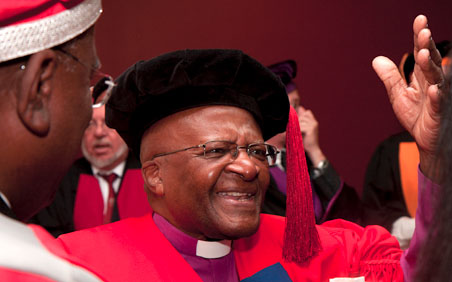 |
Archbishop Emeritus Desmond Tutu after receiving his honorary doctorate in Theology at the UFS.
- Photo: Hannes Pieterse |
The University of the Free State (UFS) awarded an honorary doctorate to Archbishop Emeritus Desmond Tutu on Thursday, 27 January 2011. The graduation ceremony, which was attended by guests from across the country marks a milestone in the history of the university.
Amongst the guests were the ambassador of the USA to South Africa, Mr Donald Gips; the British High Commissioner to South Africa, Dr Nicola Brewer; members of the local government; Ms Barbara Hogan, former Minister of Public Works and the daughters of Bram Fischer, Ruth Fischer-Rice and Ilse Fischer-Wilson. Friends of Dr Tutu, Dr Ahmed Kathrada, Ms Barbara Hogan and Dr Allan and Ms Elna Boesak also attended the occasion.
The UFS also received a message of congratulations from the Deputy President of South Africa, Mr Kgalema Motlanthe. “The choice to honour this exemplar of virtue to which most of the world still look for direction as it buckles under social, political and economic difficulties is laudable in all respects,” he said.
Prof. Jonathan Jansen, Vice-Chancellor and Rector of the UFS, said: “We honour a great son of South Africa who made a tremendous contribution to peace, reconciliation and justice in South Africa and in the world.
“There were times when few of us thought apartheid would end in our lifetime, yet you stood as a rock reassuring us, not about a black future, but about our common future. For this reason, Arch, we would not miss this opportunity to honour you for any reason whatsoever.
“You, Sir, are a Jew among Muslims, a Christian among Hindus, a Catholic among Anglicans, a bridge-builder among all of us. That is why we love you; because you look deeper and see further than all of us.”
According to Prof. Francois Tolmie, Dean of the UFS’s Faculty of Theology, the university honours Dr Tutu for his contribution as theologian – through his teaching and the books he wrote – as well as for the role he played in bringing about reconciliation in South Africa as well as in the rest of the world. The university also honours Dr Tutu as a moral and spiritual leader who never sacrificed his integrity as a Christian.
Apart from being a church leader and a leading world figure, Dr Tutu is the author of several books and also held a number of teaching posts at various tertiary institutions.
In 1984, he received the Nobel Peace Prize for his role as a unifying leader figure in the campaign to abolish apartheid in South Africa. A further highlight in his career was his election as Archbishop of Cape Town in 1986. He was the first black African to serve in this position, which placed him at the head of the Anglican Church in South Africa.
Many South Africans also remember the role he played when President Nelson Mandela appointed him in December 1995 to chair the Truth and Reconciliation Commission, which was established to investigate human rights violations during the apartheid era. The Archbishop guided the nation in the process of choosing forgiveness over revenge and in so doing set a historic international precedent.
In 1996, he retired as Archbishop of Cape Town but continues to speak out in favour of human rights, equality and social justice in South Africa and throughout the world.
In August 2009, President Barack Obama presented him with the Medal of Freedom, the United States of America’s highest civilian honour. Dr Desmond Tutu is recognised around the world as a moral leader committed to the human rights of all people.
Today he is chairman of The Elders, a group of world leaders who, in view of their integrity and leadership, are equipped to deal with some of the world’s most pressing problems.
Prof. Tolmie says: “It is often asked how Dr Tutu could have achieved all this in the span of one lifetime. Some people would refer to his warm personality or his humanness, his deep sense of humility or his wonderful sense of humour. Probing a little deeper, however, one is struck by Dr Tutu’s deep relationship with God. He is known as a man of faith, a man of prayer. He lives his life coram Deo, in the presence of God.”
Dr Tutu also lead the introduction ceremony of the UFS’s International Institute for Studies in Race, Reconciliation and Social Justice.
Media Release
27 January 2011
Issued by: Lacea Loader
Director: Strategic Communication (actg)
Tel: 051 401 2584
Cell: 083 645 2454
E-mail:
news@ufs.ac.za